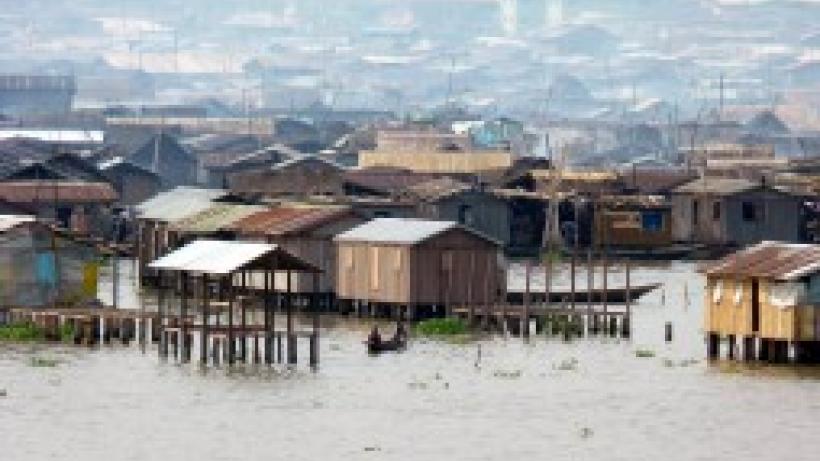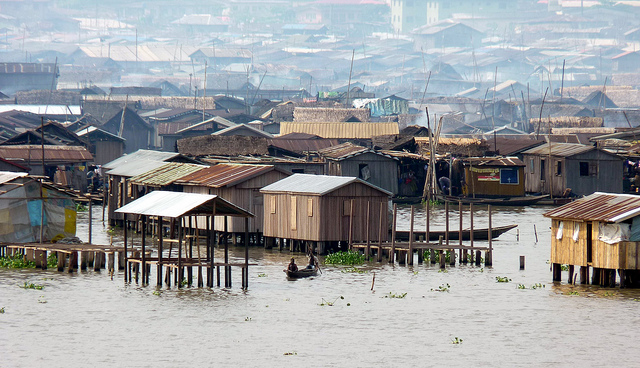
Hidden inequality: Data unmasked
New data on median incomes suggests that traditional data on mean income might be skewing measures of inequality and poverty. Today's blog, by IGC Country Economist Sally Murray takes a look at the hidden depths of inequality in Nigeria, as uncovered by newly published data collected by the Center of Global Development.
Off the coast of Lagos, Nigeria, land is being reclaimed from the sea to host Eko Atlantic, a futuristic new city for the mega-rich. Touted as the ‘Hong Kong of Africa’, it will boast the continent’s largest shopping mall and financial hub, a marina, private international schools and hospitals, and 250,000 residents.
Ten kilometres away is the slum neighbourhood of Makoko, also built on water and already home to 250,000 people. They live along polluted waterways, in densely packed stilted houses, under constant threat of demolition by government.
by looking at median income statistics we can see just how poorly Nigeria’s economy is set up to serve most people, and how rampant inequality there is compared to other countries.
It’s well known that Nigeria’s richest and poorest people are worlds apart. But what about the typical, middle-income person? How does Nigeria’s growth, wealth and poverty affect them? Until earlier this month, it was very hard to access data on mid-income groups in most countries. Now, for the first time, the US think-tank Center for Global Development (CGD) has published figures on the middle (median) incomes of almost all countries.
Relying purely on mean income data masks deeper inequalities
It turns out that the middle earner in Nigeria takes home just US$1.80 each day — below the international poverty line of US$1.90 a day. The data also shows that in several countries with a similar GDP (gross domestic product) per capita to Nigeria, the middle earner has a more comfortable living: more than US$7 in Tonga and US$9 in Bolivia, for example. Meanwhile, in Nigeria’s northern neighbour Niger — six times poorer as a country per capita — the middle earner lives on US$1.90 per day.
It’s incredible that this data wasn’t published before. We knew Nigeria had an inequality problem, but until now discussions have been steered by per capita (mean) incomes — and these are heavily skewed by the incomes of the mega-rich. But by looking at median income statistics we can see just how poorly Nigeria’s economy is set up to serve most people, and how rampant inequality there is compared to other countries.

Image credit: Heinrich-Böll-Stiftung
For countries at the lower end of the income scale, median income is not just a tangible statistic that can be easily understood, it is also highly correlated with the sorts of measures we want it to illuminate: poverty, inequality and the living standard of the majority.
If it’s so useful, why has median income data only just been made available? CGD had to use a convoluted method to drag it (kicking and screaming) from the World Bank’s PovcalNet, a repository of data from over 850 household surveys from 126 countries, first made publicly available five years ago. Much of that data is itself recent: when global poverty rates were estimated in 1990, the analysis had only 22 household surveys to draw on.
Despite big leaps in data collection, variables for cross-country comparison remain limited
Today, the science of household data collection and analysis remains far from perfect: a huge amount of data has been collected, but only the simplest, most crucial, income, consumption and inequality data is readily comparable across countries.
The World Bank’s publication of core household survey data , and CGD’s follow-up with median income data, is, however, a good step, and part of a wider trend of increased sharing (and more thoughtful use) of data about poverty and its alleviation.
In Rwanda, the national statistics agency often draws on the motto: “If you don’t count, you don’t count!” Data from sources such as household surveys offer the best chance of thoroughly testing our prejudices about the complex and varied lives of the poor. The more people generate and share this kind of data, the more scrutiny and thoughtfulness will be applied to it, and the more reliably policymakers can align their efforts to tackle chronic poverty with people’s real needs.
This article was originally published on SciDev.Net. Read the original article.
//
